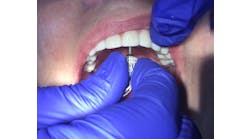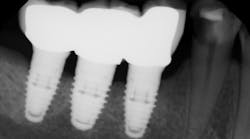How general dentists and periodontists can provide personalized preventive care for patients
Dentistry may be first health-care profession to incorporate genetic approach to long-term chronic disease management.
The study “Patient Stratification for Preventive Dental Care,” recently published in the Journal of Dental Research, provides unique insight into the future of dentistry and personalized health care.
Conducted at the University of Michigan, the study accessed 16 years of claims data of more than 5,000 patients and looked at tooth loss related to three risk factors: IL-1 genotype, diabetes, and smoking. A careful review of each patient’s health history was performed and each patient underwent genetic testing (via a check swab sample) to determine his or her genetic susceptibility to periodontitis based on the presence of the IL-1 gene, which has been associated with an increased risk of periodontitis. A growing body of evidence indicates that periodontitis is driven by inherent factors in an individual that alters the individual’s response to the bacteria that triggers periodontitis. Essentially, the study found that if a patient had none of the risk factors, then the incidence of tooth loss was unchanged despite the patient being seen by a dentist for either once or twice yearly cleanings. For those patients who had one of the risk factors, one preventive visit was not sufficient, and if they had two risk factors, more than two visits yearly were needed to minimize tooth loss. The results lead to the question, “What do these findings signal to both the general dentist and the periodontist?”
RELATED |The link between periodontitis and cardiovascular disease: A brief overview
To answer this question, first we need to think about the current U.S. population and how it is changing. We know that more than 2,000,000 people a year are reaching the age of 65, and those ages 70 years old and older will double in the years to come to more than 71,000,000. We are indeed living longer with higher expectations of an enhanced quality of life. However, we are living with more chronic disease and are taking more medications than ever before.
The management of chronic diseases would be more predictable if we could identify the subset of the population who are most susceptible to the disease in question and institute a preventive regime before the signs and symptoms of the disease are manifested. Considering that health-care costs in this country are skyrocketing largely due to people living longer, it makes sense that dentists can play a unique role in helping patients maintain the health and well-being necessary to lead long, high-quality lives.
With regard to preventing tooth loss and periodontitis, general dentists should incorporate a comprehensive periodontal evaluation on all adults over the age of 35. This evaluation may now include genetic testing and keying important systemic risk factors identified in the study to segregate their patients into “high risk” management regimes. The results of this study enable us to have the conversation with our patients, and tell them that based on their risk factors, more intense and frequent preventive visits and examinations will be required to keep them healthy. It is a more personalized approach to dental care, instead of simply pigeonholing them into a one-size-fits-all recommendation. If signs of periodontitis do occur, patients can be identified at the earliest stages, and the decision to partner with a periodontist can be made based not only on the presence of disease, but based on risk. This is very powerful both from a treatment perspective and also in terms of communicating to the patient the importance of preventive visits, treatment, and/or referral to the specialist.
As a periodontist, I would want to see patients at high risk earlier in the disease process, while those at lower risk may receive initial treatment with the general dentist. My job as a specialist is to manage risk — both the patient’s and the dentist’s. There is nothing more frustrating for a dentist than to treat a patient who continues to go downhill, and certainly patients become frustrated and lose confidence in dentistry when that occurs. Now, based on identifying these risk factors, we have an objective tool to identify those who would most benefit from our services, explain what is happening, and allocate health-care dollars and advanced treatment regimens to those who would most likely benefit with early intervention. Dentistry may indeed be the first health-care profession to incorporate a genetic approach to long-term chronic disease management.







